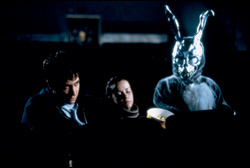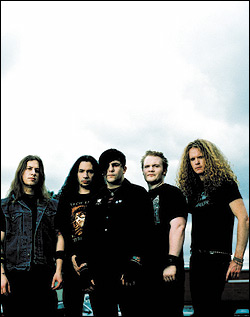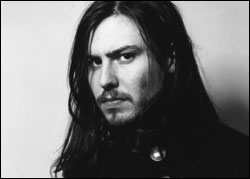11 a.m. Wednesday, May 19, 2004: This story materializes on SW‘s home page. Now flash forward 10 days . . . seven hours . . . 30 minutes . . . one or two seconds, give or take. That is when the world will end for Richard Kelly. OK, so the deadline isn’t quite so ominous without a malformed man-sized bunny orator to deliver it, but that doesn’t mean it’s not real. When that time elapses (6:30 p.m. Saturday, May 29, at Pacific Place), the wunderkind behind 2001’s audaciously original coming-of-age time-travel mindfuck Donnie Darko will stand before a curious SIFF assemblage to unveil that film’s brand-new 133-minute director’s cut. Believe it or not, as Kelly recently suggested via phone, his career now hinges on that world-premiere screening. How fitting that we have to toggle back and forth in time to understand why.
Oct. 28, 2001: It doesn’t take Marty McFly and a DeLorean to predict that, following today’s debut in theaters, Darko will dwindle quickly at the box office. The plot sounds ludicrous when condensed to a salable blurb: “A morose Dukakis-era teen befriends an imaginary 6-foot rabbit who informs him that the universe will collapse in 28 days.” It sounds like a toker’s Harvey. And one of the major plot devices—a commercial airliner engine crashing into a suburban home—is way too close for comfort just after 9/11. Four and a half million smackers’ worth of liquid wormholes, dirty Smurf jokes, and Patrick Swayze cast as a pedophile will yield just over 500 grand at the domestic box office. Looks like we’ll be calling lead Jake Gyllenhaal “Bubble Boy” for the foreseeable future.
Feb. 4, 2003: 20th Century Fox releases the Darko DVD, loaded with 20 deleted and extended scenes and tons of cryptic commentary from Kelly. Thanks to infectious word of mouth and www.donniedarko.com, which features helpful excerpts from the film’s The Philosophy of Time Travel book, his quirky, arresting sci-fi meditation is not only a midnight-movie favorite but a legit cult sensation. The ambiguous coda inspires multiple interpretations. Kelly has a flair for meshing oblique ’80s pop-culture references with high-concept metaphysical sound bites. Darko begins to look like Pulp Fiction Redux. Even better, its potent quotables—like “Chut up,” “suck a fuck,” and “anger prisoner”—are not yet soiled by frat boys. The DVD reels in $10 million, and Darko‘s finally—ain’t it apt—in the black.
May 10, 2004: All this is more than Kelly could ever have hoped for—and, simultaneously, not enough. He’s overwhelmed by Darko‘s slow, steady groundswell and, despite the desire to move on, has more of the story to tell. Having no real financial stake in the director’s cut, he swears this isn’t another sad example of squeezing a good orange dry, but merely fulfilling a complicated idea cut short by a rigid, get-it-done-in-two-hours studio ultimatum.
“A lot of my follow-up projects are significantly more expensive, and studios have been very hesitant to give me the autonomy to engage them the way I really need to engage them,” Kelly admits. The financial goal is to use Seattle as a microcosm to see if Darko can play the suburbs, perhaps insert it into “six to eight” Emerald City theaters after the festival, and go from there. “My hope is that it can be this sort of ‘anti–summer blockbuster’ if people don’t want to see Van Helsing for the fourth time.”
The aesthetic goal is to “give the audiences a bit more of an answer, while proposing a significant number of questions at the same time.” Unsurprisingly, Kelly’s 100 percent mum on the new material, although it’s not all retreads from the DVD cuts. New visual effects and music are promised, too, and here’s where we get into Lucas-botching-Star Wars territory; the soundtrack played a memorable role in the original Darko, particularly two Tears for Fears songs (including Gary Jules’ spooky cover of “Mad World”), in critical offsetting montages. Kelly promises that he didn’t fuck up the vibe, snarkily adding, “Now there’s a Britney Spears song in the end credits.” Not.
Sept. 24, 1991: Nirvana’s Nevermind is released, irrevocably changing the lives and perspectives of 80 gazillion people, including, it seems, Richard Kelly. “It’s interesting that they’ve chosen Seattle as the guinea pig for ‘Can this movie cross over or not?'” he laughs. “When you think of Seattle and you think of culture, you think of Kurt Cobain and what he continues to represent—this kind of middle finger to the system. It seems to be in the DNA of that city.” He means that as a compliment, and it sounds that way, too.
“I hope Kurt Cobain is still alive and well,” Kelly continues. “Maybe it sounds weird to associate him with this film, but everything about [Darko] is sort of going against the corporate nature of thinking. Look, Nirvana sold millions and millions of records. The greatest thing to happen is for counterculture art to invade the mainstream.”
No duh, Richard. Of course, “duh” is a product of fear. Reintroducing an even longer, more nebulous Darko to the sticks? Scary prospect. Glad he’s trying.







